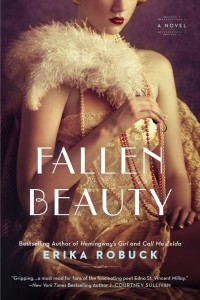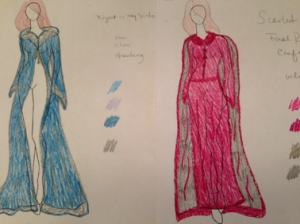 We're turning the site over to one of our favorite authors today--the incredibly talented Erika Robuck. Her latest, Fallen Beauty is out March 4th! (And just for the record, it's AWESOME and you should pre-order a copy RIGHT NOW.) Today she's dishing on the fashion, fabric and design in Fallen Beauty.
And we've got ONE copy of Fallen Beauty to give away! Leave a comment and you'll be entered to win. Contest will close Sunday, March 2nd after Noon PST.
We're turning the site over to one of our favorite authors today--the incredibly talented Erika Robuck. Her latest, Fallen Beauty is out March 4th! (And just for the record, it's AWESOME and you should pre-order a copy RIGHT NOW.) Today she's dishing on the fashion, fabric and design in Fallen Beauty.
And we've got ONE copy of Fallen Beauty to give away! Leave a comment and you'll be entered to win. Contest will close Sunday, March 2nd after Noon PST.
Fashion, Fabric and Design in FALLEN BEAUTY
“The pleasure of working with exquisite fabric filled my nights as a lover would. I’d fantasize about the work all day, the feel of the silks, velvets, furs, the glint of shiny silver lines in crumpled silver fabric, the sheen of moon blue spread over my lap like light on a snowy field…” FALLEN BEAUTY
Writing has become a bit like method acting for me. I have to take on the character to effectively convey her. Sometimes that means visiting places she has gone, drinking drinks she has tried, or reading the books she has read. Other times it means engaging in her profession. The protagonist of FALLEN BEAUTY is a seamstress, and my ability to sew is crude. From my youth, however, I have enjoyed designing and choosing clothing and fabrics, so I brought my knowledge of this to my character’s commission: to create a poetry reading tour wardrobe for Edna St. Vincent Millay.
Edna St. Vincent Millay—discovered while barely out of her teens for her poem Renascence, and the third woman to win the Pulitzer for her poetry—was trained in the theater and enjoyed dressing in elaborate costume. She was known to wear layers of jewel toned velvet with long trains to her performances, and this was especially dramatic considering she was under five feet tall. She sold out thousand seat auditoriums in the 1920s and 30s and made $30,000 a year at her peak. By all accounts, her readings were hypnotic, and though small in stature, Millay’s presence was commanding.
My seamstress designs many ensembles for Millay, but the photo depicts two cloaks that are particularly important to the story. Both are inspired by poems of Millay, as is my character, and the themes of the novel are heavily influenced by those of THE SCARLET LETTER. It seemed appropriate that the reader would come to know a sensual woman like Millay through another sensual woman deeply connected to her craft through fabric and design.
I had great fun pretending to be a seamstress working for a scandalous Bohemian poet, but when the novel was finished, I was left in awe of Millay and longed for the “second Renascence” of this now obscure poet. It is my deepest hope that I am able to resurrect new interest in Millay through FALLEN BEAUTY.
Thanks, Erika!

